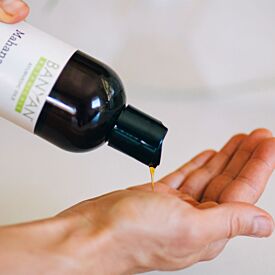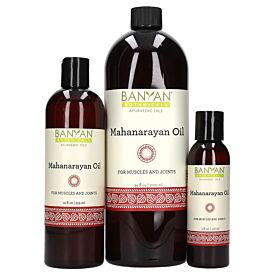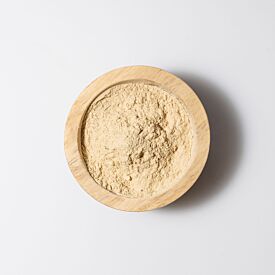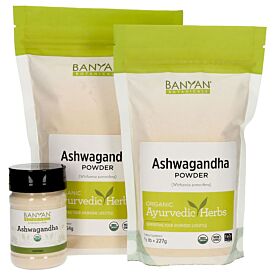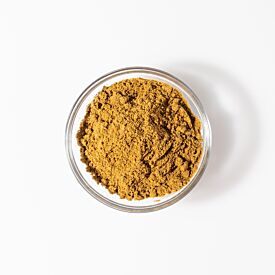Balancing Vata in the Joints

Vata-type joint ailments are initiated by excess vata in the body. The imbalance typically begins in the digestive tract, where vata has accumulated as a result of a vata-aggravating diet or lifestyle. This might involve eating foods that are dry, rough, or difficult to digest.
Vata is also aggravated by eating on the run, being overly busy, stressed out, constantly on the move, having inadequate downtime, generally lacking routine, or exercising inappropriately (or excessively). These and other vata-provoking influences elevate vata in the colon, vata’s natural home in the body.
As the excess begins to accumulate, it can cause irregular appetite, frequent gas and bloating, a tendency toward constipation, delicate digestion, dry skin, hair, or nails, fear and anxious feelings, loneliness, racing thoughts, rapid speech, and other vata symptoms.
Meanwhile, the excess vata also compromises agni (the metabolic fire), which can initiate the formation of ama (natural toxins) in the GI tract.
This is where the joints come in; the joints have a natural affinity for imbalances that enter circulation via the colon because the colon is the seat (home) of vata, and the bones and joints are another important gathering place for vata in the body.
On the other hand, the ama shares many qualities with kapha dosha and therefore has an affinity with shleshaka kapha, a subtype of kapha that is primarily responsible for cushioning the joints.
If the condition of the local agni in any of these tissues is weak, the excess vata and ama can invade them, causing the gradual wear and tear of the joints as they begin to dry out, break down, and deteriorate.
Over time, in the absence of proper nourishment, lubrication, and cushioning in the joints, the bones themselves can become rough, exposed, damaged, or deformed.
How to Identify Excess Vata in the Joints
So what does this process feel like in our bodies? Vata in the joints causes dryness and frequent cracking or popping upon movement—usually without swelling.1
The joints tend to feel cold to the touch, often have specific point tenderness, and tend to be most painful upon movement—especially as a result of highly vata-aggravating activities like jogging, jumping, other high-impact activities, and strenuous exercise.2
Tips for Balancing Vata
In order to balance vata in the joints, we need to clear the vata and ama from the joint space and send it back to the colon, where it can be eliminated.
But we simultaneously need to tend to agni—both in the digestive tract and in the bone and joint tissues—to ensure that the vata-aggravation, the subsequent creation of ama, and their mutual intrusion into the joint spaces is halted.
Each of the following recommendations supports this process in its own way.
Eat a Vata-Balancing Diet
Because joint ailments typically begin in the digestive tract, following an appropriate vata-balancing diet is essential to the healing process.
In the case of excess vata (which is light, dry, rough, cold, and clear), focus on ingesting oily, grounding, nourishing foods that are well-seasoned with agni-kindling spices like black pepper, cardamom, cinnamon, cloves, cumin, fennel, garlic, ginger, nutmeg, paprika, saffron, tarragon, and turmeric.
Favor the sweet, sour, and salty tastes while reducing exposure to the pungent, bitter, and astringent tastes. Include generous amounts of high-quality, organic oils like ghee, sesame oil, and olive oil.
Drink at least 60–80 ounces of fluid each day. Water and herbal teas that are either warm or hot will be best. Do your best to avoid cold foods and drinks (including salads), and try to steer clear of foods that can further aggravate vata in the joints, like nightshades (tomato, potato, eggplant, bell peppers), or legumes, barley, corn, crackers, and popcorn.3
In addition, you can stoke the digestive fire about thirty minutes before lunch and dinner by chewing a slice of fresh ginger (about the size of a nickel) with a pinch of sea salt, a few drops of lime juice, and about ¼ teaspoon honey.
If this feels overwhelming, you could take one or two Vata Digest tablets about thirty minutes before lunch and dinner instead. You can also sprinkle the powdered version of this formula, Hingvastak, on your food like pepper.
Massage the Joints with Warm Oil
The lubricating, nourishing qualities of oil help counter vata’s dry, rough influence on the joints.
Mahanarayan Oil
This herbal oil is wonderful for calming vata in the joints. It is warming, soothing, lubricating, strengthening, and rejuvenating, thereby supporting optimal function and comfortable movement in the joints.
Simply massage the joints with warm Mahanarayan Oil and then apply moist heat.4 You can take a bath, soak the oiled joint in warm water, or wrap it with a damp, warm washcloth and cover that with a hot water bottle or a therapeutic water bag (a secure zip-lock can work, too).
This therapy encourages circulation, helps clear and digest ama locally, and supports the body’s natural healing process.
Ashwagandha Bala Oil
This blend is very nourishing, strengthening, rejuvenative, and it has a particular affinity for the muscle and connective tissue. As a result, Ashwagandha Bala Oil may be particularly supportive if the muscles and the fascia are playing a role in your joint discomfort.
Castor Oil
Castor Oil helps balance conditions where vata and ama mix in the joint space.5 It is very effective at scraping accumulations of ama from the tissues while lubricating the joints and encouraging local circulation.
Establish a Routine
Vata is profoundly buoyed by consistency in structure and routine. If this is a new concept for you, you can begin simply by moving toward awakening and going to bed at the same times each day, and eating your meals at consistent times from one day to the next.
Beyond these foundations, focus on establishing a vata-balancing daily routine, including whichever of the following vata-friendly additions appeal to you.
Exercise
Choose activities that are gentle, grounding, and relatively slow—not overly stimulating. Favor things like chi gong, tai chi, walking, light hiking, light jogging, swimming, or gentle cycling. Also, be sure to balance exercise with adequate rest and rejuvenation.
Yoga
Embrace a Vata-Pacifying Yoga practice. Poses that are especially supportive of vata-type joint issues include Feet and Ankle Warm Up, Wrist Stretch, Seated Forward Bend (Paschimottanasana), Knees to Chest Apanasana), and Bridge (Setu Bandha Sarvangasana).6
If you prefer a flow, a handful of very slow and purposeful Sun Salutations (Surya Namaskar) help ground vata while improving circulation throughout the body, supporting joint health.
(Note: Bridge pose will appear under the Pitta-Pacifying Yoga Department, but is also wonderful for vata in the joints).
Pranayama
Just five to fifteen minutes of vata-pacifying pranayama every day on an empty stomach can be transformative. These practices are deeply vata-pacifying, but also help digest and clear ama. In particular, consider the following practices:
Nadi Shodhana (Alternate Nostril Breathing) clears and releases toxins while awakening and cleansing the subtle channels of the body; it is perfect for balancing vata throughout the body.
Kapalabhati (Skull Shining Breath) helps stimulate synovial circulation in the joints, which can be very beneficial when excess vata has accumulated there.
Bhramari (Humming Bee Breath) soothes and supports the nervous system while encouraging healing in the bodily tissues.
Meditation
Consider adding five to ten minutes of Empty Bowl Meditation to your daily routine to effectively quiet the mind and calm the nervous system, which will support the joints—both locally and systemically.
Drink Gold Water
Pure gold is strengthening, nourishing, and very supportive of excess vata in the joints. The healing qualities of gold can be harnessed by preparing water infused with the subtle essence of gold.
Simply place a pure (ideally, twenty-four karat) gold item—like a gold band—in 2 cups of water, bring to a boil, and boil until only 1 cup remains. Remove the gold item (it will not be damaged at all by this process), then cool and store the gold water. Take 1 teaspoon of this water two to three times each day.7
Consider the Addition of Vata-Balancing Herbs
Herbs can help balance vata systemically, but can also optimize the health of the digestive tract (where many joint imbalances originate), kindle agni throughout the system, and encourage the elimination of ama—both from the GI tract and from the joints themselves.
More specific information about how each of these herbs and formulas supports the joints is provided below.
Yogaraj Guggulu
Guggulu resin is a penetrating, detoxifying, and rejuvenating herb renowned for its ability to scrape naturally accumulating toxins from the gross and subtle channels of the body (physical and energetic pathways), but also for its capacity to carry other herbs deep into specific tissues. This traditional Ayurvedic formula has long been used to balance excess vata in the joints, nerves, and muscles.
Take one Yogaraj Guggulu tablet three times per day.8 Or, if you prefer, this formula is also available as a powder; take ¼ teaspoon three times per day with warm water.9
Guduchi
Guduchi is a powerful nutritive tonic that effectively removes excess vata from the body. It also cleanses the blood, supports circulation, tonifies the nervous system, and helps clear ama from the body. It is, therefore, a very effective source of support when excess vata has settled in the joints.10
Ashwagandha
Ashwagandha is one of the best herbs for calming vata. It is strengthening, clarifying, and rejuvenating. It also has a particular affinity for the muscle and bone tissues and supports comfortable joint movement.
Ashwagandha is available in several forms: tablets, powder, and a liquid extract.
Turmeric
While Turmeric is familiar to most of us as a kitchen spice, it offers a plethora of health benefits. Its warming, clarifying capacity is very balancing when there is excess vata in the joints. It strengthens digestion, helps eliminate natural toxins from the GI tract, and purifies the blood—all while soothing and nourishing the joint tissues.
Turmeric is available in several forms: tablets, powder, and a liquid extract.
Licorice
Licorice is naturally moisturizing and therefore supports proper lubrication in the gut as well as in the tissues.
More General Support of Vata
Balance vata systemically with Healthy Vata tablets. To help clear vata from your channels of digestion and elimination, consider Vata Digest tablets. You can also use Hingvastak, the powdered form of Vata Digest, which can be taken alone or sprinkled on your food like pepper.
And finally, if vata is truly the primary concern, consider taking Haritaki instead of triphala to more specifically balance vata throughout the system.


